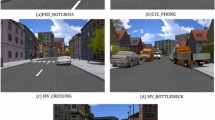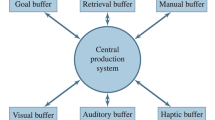Abstract
Currently, car manufacturers, suppliers, and IT companies are surpassing each other with ambitious plans regarding their driving automation technology. However, even the most optimistic announcements grant that, for a certain time, a human driver cannot be replaced in all driving situations. Hence, human drivers will still be a part of future traffic by working together with automation systems. Analyzing the joint decision-making process of such a human–machine system in automated driving provides a better understanding of the resulting traffic system. In this paper, a driving simulator study with 33 participants focusing on the utility of cooperative driver–vehicle systems with the use case of highway driving is presented. Based on the study’s results, a model that explains the linkage between subjective measures such as the perceived utility and objective driving data is derived. Moreover, on an individual level, models are parameterized by using driving states as predictors and the individual utility perceived in a driving situation as response. This individual utility can be used for predicting driving actions such as the initiation of overtaking maneuvers.








Similar content being viewed by others
References
Abbink D (2006) Neuromuscular analysis of haptic gas pedal feedback during car following (Dissertation). TU Delft, Delft
Altendorf EEO, Flemisch FO (2015) Prediction of driving behavior in cooperative guidance and control: a first game-theoretic approach. Kogn Syst 2:10. https://doi.org/10.17185/duepublico/37693
Altendorf E, Weßel G, Baltzer M, Canpolat Y, Flemisch FO (2016a) Joint decision making and cooperative driver-vehicle interaction during critical driving situations. I-Com 15(3):265–281
Altendorf EEO, Baltzer MCA, Heesen M, Kienle M, Weißgerber T, Flemisch FO (2016) H-Mode. In: Winner H, Hakuli S, Lotz F, Singer C (eds.) Handbook of driver assistance systems: basic information, components and systems for active safety and comfort. Springer International Publishing, Cham, pp. 1499–1518. https://doi.org/10.1007/978-3-319-12352-3_60
Altendorf EEO, SchreckC, Flemisch FO (2017) A new method and results for analyzing decision-making processes in automated driving on highways. In: Stanton NA, Landry S, Di Bucchianico G, Vallicelli A (eds.) Advances in human aspects of transportation: proceedings of the AHFE 2016 international conference on human factors in transportation. Springer International Publishing, Cham, pp. 571–583. https://doi.org/10.1007/978-3-319-41682-3_48
Baltzer MCA, Flemisch FO, Altendorf EEO, Meier ST (2014) Mediating the interaction between human and automation during the arbitration processes in cooperative guidance and control of highly automated vehicles. In: Proceedings of the 5th international conference on applied human factors and ergonomics AHFE
Baltzer MCA, López D, Flemisch F (2019) Towards an interaction pattern language for human machine cooperation and cooperative movement. Cognition, Technology & Work, 1–14
Biester L (2008) Cooperative automation in automobiles. Humboldt-Universität, Berlin
Bortz J, Schuster C (2016) Statistik für Human- und Sozialwissenschaftler: Mit 163 Tabellen (Limitierte Sonderausgabe, 7., vollständig überarberarbeitete und, erweiterte edn. Springer, Berlin)
Bubb H (1993) Ergonomie. 3. Aufl., Kap. 5.3 Systemergonomische Gestaltung, (S. 390–420). Carl Hanser, München
Donges E (1999) A conceptual framework for active safety in road traffic. Veh Syst Dyn 32(2–3):113–128
Draper NR, Smith H (2014) Applied regression analysis. Wiley, New York
Eggert J, Klingelschmitt S, Damerow F (2015) The foresighted driver: future adas based on generalized predictive risk estimation. In: FAST-zero 2015 symposium
Endsley MR (1995) Toward a theory of situation awareness in dynamic systems. Hum Factors J Hum Factors Ergon Soc 37(1):32–64
Field A (2013) Discovering statistics using IBM SPSS statistics. Sage, Thousand Oaks
Flemisch FO, Adams CA, Conway SR, Goodrich KH, Palmer MT, Schutte PC (2003) The H-Metaphor as a guideline for vehicle automation and interaction (NASA Technical Memorandum No. NASA/TM-2003-212672)
Flemisch F, Kelsch J, Löper C, Schieben A, Schindler J, Heesen M (2008) Cooperative control and active interfaces for vehicle assistance and automation. In: FISITA World automotive congress vol 1, pp. 301–310
Flemisch FO, Bengler KJ, Bubb H, Winner H, Bruder R (2014) Towards cooperative guidance and control of highly automated vehicles: h-mode and conduct-by-wire. Ergonomics 57:343–360. https://doi.org/10.1080/00140139.2013.869355
Flemisch FO, Abbink D, Itoh M, Pacaux-Lemoine M-P, Weßel G (2016) Shared control is the sharp end of cooperation: towards a common framework of joint action, shared control and human machine cooperation. In: 13th IFAC/IFIP/IFORS/IEA symposium on analysis, design, and evaluation of human–machine systems. Kyoto, Japan
Flemisch FO, Winner H, Bruder R, Bengler KJ (2016b) Cooperative guidance, control, and automation. In: Winner H, Hakuli S, Lotz F, Singer C (eds) Handbook of driver assistance systems: basic information, components and systems for active safety and comfort. Springer International Publishing, Cham, pp 1471–1481. https://doi.org/10.1007/978-3-319-12352-3_58
Flemisch FO, Abbink D, Itoh M, Pacaux-Lemoine M-P, Weßel G (2019) Shared control is the sharp end of cooperation: Towards a common framework of joint action, shared control and human machine cooperation. Cogn Technol Work 19 (accepted)
Hoc J-M (2000) From human–machine interaction to human–machine cooperation. Ergonomics 43(7):833–843
Hollnagel E, Woods DD (1983) Cognitive systems engineering: new wine in new bottles. Int J Man Mach Stud 18(6):583–600
Holzmann F (2008) Adaptive cooperation between driver and assistant system. Adaptive cooperation between driver and assistant system. Springer, New York, pp 11–19
Kesting A, Treiber M, Helbing D (2007) General lane-changing model MOBIL for car-following models. Transp Res Record J Transp Res Board 1999:86–94
Kita H (1999) A merging–giveway interaction model of cars in a merging section: a game theoretic analysis. Transp Res Part A 33:305–312
Kita H, Kouchi A (2011) A utility-based evaluation method on the perceived quality of traffic service. Proc Soc Behav Sci 16:820–831
Koppelman FS (1981) Non-linear utility functions in models of travel choice behavior. Transportation 10(2):127–146
Michon JA (1985) A critical view of driver behavior models: what do we know, what should we do? In: Evans L, Schwing RC (eds) Human behavior and traffic safety. Springer, Boston
Millot P, Pacaux-Lemoine M (1998) An attempt for generic concepts toward human-machine cooperation. In: SMC'98 Conference Proceedings. 1998 IEEE International Conference on Systems, Man, and Cybernetics (Cat. No. 98CH36218) Vol 1, pp 1044–1049, IEEE
Nilsson J, Silvlin J, Brannstrom M, Coelingh E, Fredriksson J (2016) If, when, and how to perform lane change maneuvers on highways. IEEE Intell Transp Syst Mag 8(4):68–78
Pacaux-Lemoine M-P, Debernard S (2002) Common work space for human–machine cooperation in air traffic control. Control Eng Pract 10:571–576. https://doi.org/10.1016/S0967-0661(01)00060-0
Rasmussen J (1983) Skills, rules, and knowledge; signals, signs, and symbols, and other distinctions in human performance models. IEEE Trans Syst Man Cybern 13:257–266. https://doi.org/10.1109/TSMC.1983.6313160
Rasmussen E (2000) Games and information: an introduction to game theory, 3rd edn. Blackwell Publishers Inc., New York
Salas E, Prince C, Baker DP, Shrestha L (1995) Situation awareness in team performance: implications for measurement and training. Hum Factors J Hum Factors Ergon Soc 37(1):123–136
Schubert R (2012) Evaluating the utility of driving: toward automated decision making under uncertainty. IEEE Trans Intell Transp Syst 13(1):354–364
Sheridan TB (2002) Humans and automation: system design and research issues. Wiley, New York
Weßel G, Altendorf EEO, Schwalm M, Canpolat Y, Burghardt C, Flemisch FO (2019) Nudge me please: Self-determined decisions in human-machine interaction. Cogn Technol Work (accepted)
Winner H, Schopper M (2016) Adaptive cruise control. In: Winner H, Hakuli S, Lotz F, Singer C (eds) Handbook of driver assistance systems: basic information, components and systems for active safety and comfort. Springer International Publishing, Cham, pp 1093–1148. https://doi.org/10.1007/978-3-319-12352-3_46
Zijlstra FRH (1995) Efficiency in work behaviour: a design approach for modern tools (Dissertation). TU Delft, Delft
Zijlstra FRH, van Doorn L (1985) The construction of a subjective effort scale. Delft University of Technology, Delft
Acknowledgements
The research conducted was partly funded by the Deutsche For-schungsgemeinschaft (DFG) within the project “SPP 1835: Systemergonomie für kooperativ interagierende Automobile: Nachvollziehbarkeit des Automationsverhaltens und Eingriffsmöglichkeiten des Menschen im Normalbetrieb, a Systemgrenzen und bei Systemausfall”, and partly by RWTH Aachen University.
Author information
Authors and Affiliations
Corresponding author
Ethics declarations
Conflict of interest
The authors declare that they have no conflict of interest.
Informed consent
Informed consent was obtained from all individual participants included in the study.
Ethical approval
All procedures performed in studies involving human participants were in accordance with the ethical standards of the institutional and/or national research committee and with the 1964 Helsinki declaration and its later amendments or comparable ethical standards.
Additional information
Publisher's Note
Springer Nature remains neutral with regard to jurisdictional claims in published maps and institutional affiliations.
Rights and permissions
About this article
Cite this article
Altendorf, E., Schreck, C., Weßel, G. et al. Utility assessment in automated driving for cooperative human–machine systems. Cogn Tech Work 21, 607–619 (2019). https://doi.org/10.1007/s10111-019-00557-4
Received:
Accepted:
Published:
Issue Date:
DOI: https://doi.org/10.1007/s10111-019-00557-4




